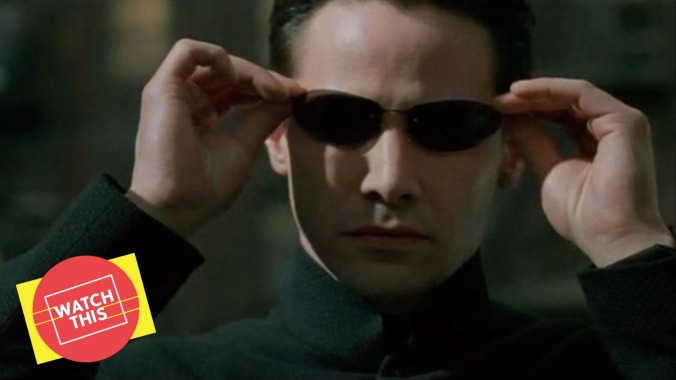The Wachowskis short-circuited audiences with the misunderstood Matrix Reloaded
In 2003, the Wachowski sisters delivered a Matrix sequel that's subversive and thrilling

Watch This offers movie recommendations inspired by new releases, premieres, current events, or occasionally just our inscrutable whims. This week: Against all odds, the event-movie movie season is in full swing, so it’s time once again to look back on unsung summer blockbusters—the flops, the critical bombs, or the merely forgotten Hollywood spectacles that deserve to be rescued from the trash bin of movie history.
The Matrix Reloaded (2003)
Between 1999 and 2003, The Matrix was done to death. Lana and Lilly Wachowski’s innovations could be seen in low-rent parodies like Kung Pow!: Enter The Fist and bullet-time-heavy video games like Max Payne. Slick kung fu, black leather trench coats, and techno were everywhere. So how would the writer-directors make a sequel to the most influential film of its time? Simple. They’d break The Matrix.
With expectations rivaled only by the Star Wars prequels, it’s no wonder that audiences rejected Reloaded and Revolutions. Though it made lots of money and scored decent reviews, the second film caught a backlash, which manifested in lackluster box office performance for the third one. A quick Google search shows how the films are viewed today, with endless articles about how to fix the sequels and what went wrong. It’s a shame, because The Matrix Reloaded is the work of two directors trying to unplug people from the mechanics of Hollywood filmmaking by deconstructing their own mythology.
Set roughly six months after the first film, Reloaded follows Morpheus (Laurence Fishburne), Trinity (Carrie-Anne Moss), and Neo (Keanu Reeves) on the dirt path towards fulfilling the prophecy, which states that Neo will free the world’s humans and destroy the machines. Said machines are digging toward the last human city of Zion as Agent Smith (Hugo Weaving, stealing every scene as a computer program cursed with free will) runs throughout the Matrix, turning its inhabitants into copies of himself. The last movie ended with Neo confidently soaring into the skies. Here, he’s giving off some real “Christ In The Desert” vibes. In some ways, his uncertainty echos the Wachowskis’ filmmaking journey. As Neo ponders what he’s supposed to do, it’s easy to picture the filmmakers struggling to figure out how to top their milestone hit. Permitted to essentially do whatever they wanted, the two went for broke, throwing out every idea they had for fear they’d never get another shot. Reloaded’s ambition is restricted only by its runtime, two hours and 15 minutes that feel downright slender by today’s blockbuster standards.

















![HBO teases new Euphoria, Larry David, and much more in 2026 sizzle reel [Updated]](https://img.pastemagazine.com/wp-content/avuploads/2025/12/12100344/MixCollage-12-Dec-2025-09-56-AM-9137.jpg)






















